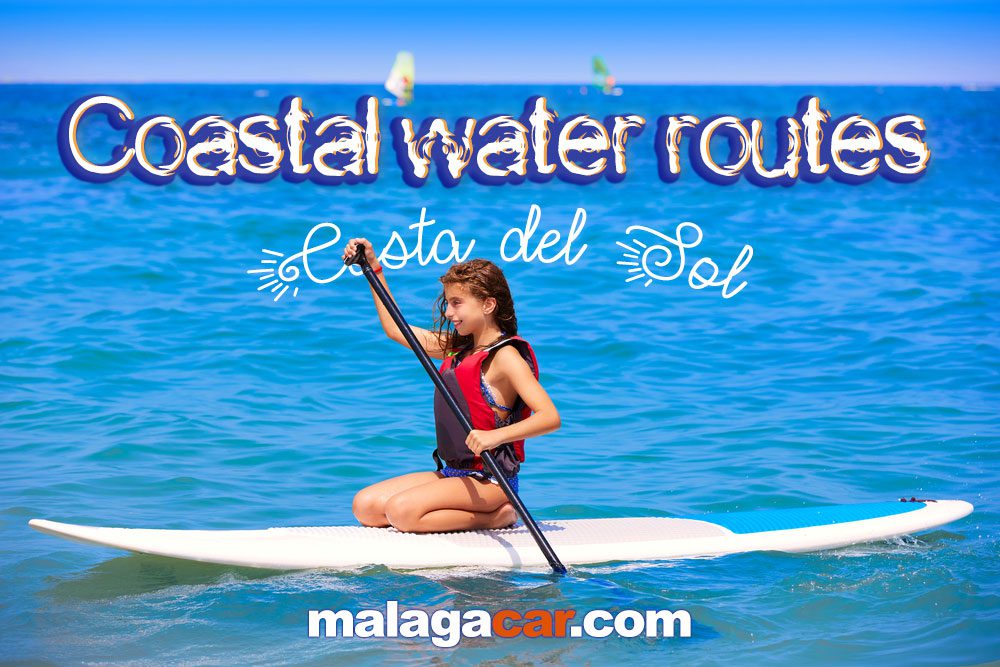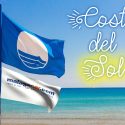
Enjoy from a very different and privileged angle with Paddle Surf and Kayak along these water routes along the Costa del Sol.
Table of Contents
The Coastal Path
As some of you may already know: The Coastal Path is a project that links the 14 coastal municipalities of Malaga from Manilva to Nerja along the entire coast. Along about 160 km you can enjoy walks next to the sea.

New this year is the creation of water routes on the Costa del Sol. This way you can discover the coast from a very different and privileged angle.
Water Routes on the Costa del Sol
Along the coastal towns of Malaga there are some beautiful water routes that you can enjoy paddling (kayaking or paddle surfing).

Snorkelling and diving enthusiasts will also find a lot of useful information: specimens of marine species and local flora are on display. You can even see the remains of ships, such as those of the ship El Delfín in Torrox. Or the submerged cave at the Peñón del Cuervo to name but a few.
The itineraries, accompanied by videos and more than 300 photographs, can be consulted on the official website.
At the same time, the website offers information on the sections of the Coastal Path that have already been completed and on other sites of interest located on the beachfront.
Water routes on the eastern Costa del Sol (Axarquía)
Coves and cliffs of the Axarquía
Each of the routes presented here has some peculiarity that makes it unique.
However, we can personally recommend above all the marine routes located on the eastern Costa del Sol.
This area, known as the Axarquia, is characterised by its rugged, mountainous terrain that reaches down to the sea forming spectacular cliffs.

Some of them even have waterfalls flowing down them, as in Nerja. In other words, the east coast has a much wilder and more natural charm than the west coast.
This whole area is also the most suitable for snorkelling and scuba diving lovers due to its crystal clear waters and rich marine flora and fauna.
Nerja

Torrecilla – Balcón de Europa – Burriana
In Nerja you can enjoy a beautiful water route of almost 6 km parallel to the old town, small cliffs and dreamlike coves.
In Nerja we can personally recommend the company Educare. They do not only rents kayaks but also offers guided tours along the cliffs of Maro, one of the most beautiful and wildest areas of the coast.
As an added bonus, they take GoPro photos during the trip which you can download from their website.
Torrox
Peñoncillo – Playa del Güilche
Also in Torrox you can enjoy from the sea the wonderful mountain scenery of the Axarquia, whose slopes reach the coast.
The route runs parallel to the coast, is linear and about 6 km long.
Algarrobo
Punta Ballenas
In the small coastal village of Algarrobo you can enjoy a beautiful and quiet sea path. It runs parallel to the historic N-340 for about 3.5 kilometres.
The views are beautiful from the water with the high mountains as a backdrop.
Almayate
Valle Niza – Almayate
2.5 kilometres of beautiful and quiet sea path parallel to the historic N-340. The views of the coast are beautiful, presided over by a hill crowned by one of the oldest watchtowers on the coast of the Costa del Sol, the Torre del Jaral.
By the way, Almayate beach is one of the quietest nudist beaches on the Costa del Sol and has an international nudist campsite.
Rincón de la Victoria
Cliffs of El Cantal
The last water route in the Axarquia before reaching Malaga passes through the cliffs of El Cantal.
The marine trail of about 2 km passes through a real geological treasure with beautiful karst formations.

By the way, if you are interested, just 1 km away are the wonderful sea caves Cueva del Tesoro and Cueva de la Victoria.
Maybe you’d like to take advantage of your stay to visit them. And they are cool in summer!
Malaga
La Araña – Peñón del Cuervo
The beach of Peñón del Cuervo is worth a visit for its curious rock. The beach also has barbecues for public use.

The marine route leads for almost 3 km along the semi-cliffed coastline with beautiful views.
You pass the Interpretation Centre for Archaeological Sites of La Araña and the Torre Vigía de Las Palomas.
In the background you can see the bay of Malaga and even the mountains of Torremolinos.
Water routes on the western Costa del Sol

The western Costa del Sol and its municipalities Torremolinos, Benalmadena, Fuengirola, Mijas, Marbella and Estepona are characterised by a very high tourist infrastructure.
It is true that in some municipalities you will not be able to enjoy the visual privileges of a water route as in the Axarquia. However, here, comfort and service are the priority.
In other words, you will practically only have to go to any beach to rent the equipment that suits you best for the day. Be it a kayak, a paddle board or even rent a boat.
The choice of beach bars and beach clubs is almost endless. There are also many beaches for people with reduced mobility.
Torremolinos
El Saltillo – Santa Clara
We are now entering the popular area of the western Costa del Sol. In case you didn’t know, Torremolinos was the cradle of tourism in Malaga in the 1950s.
Its coastline was wildly beautiful, with very long and very wide fine sandy beaches that were more like Tarifa.

Nowadays it is no longer visible due to massive construction, but Torremolinos actually stands on a cliff from which a waterfall fell into the sea. On this spot today stands the former Hotel Santa Catalina.
The whole area offers kayaking, paddleboarding and even surfing lessons and board rentals.
You can take a coastal route along the breakwater to the popular beach of La Carihuela, the old fishermens district of the town.
The area is lined with bars and chiringuitos. So you can ‘park’ your board or kayak and cool off sitting in the shade and sampling the excellent local fish before continuing your water route.
Benalmadena
Cliffs of Benalmadena
Also a part of Benalmadena differs from the typical beaches of the western Costa del Sol.
There is a stretch of several kilometres in the direction of Fuengirola where small cliffs reach the sea forming beautiful coves of crystal clear water more typical of the Axarquia.
At Carvajal beach you will find rental services and paddle surf and kayak lessons to enjoy this route.
Fuengirola
Fuengirola is characterised by a dense urbanisation in a few square metres. This has resulted in a reduction of the original width of its beaches giving way to concrete.
Although visually speaking this water route does not have much to offer in comparison to others, it may be ideal for a fun family day out near the coast.
Fuengirola’s beach infrastructure is at its best and every 500 metres or so you’ll find a beach bar where to replenish strength.
On the beach of San Francisco, next to the port, you will find rental services and paddle surf lessons.
Mijas
Torre de Calahonda & Torre Nueva
This water route of about 6 km runs along a quieter stretch of Mijas, parallel to the beautiful walkways of the Coastal Path.
At the beginning and end of this route you can see from the sea the two watchtowers that centuries ago warned of pirate raids on the coast.
It is also a good snorkelling area due to the wealth of posidonia in this area, which contributes to the transparency of the water.
Marbella
Artola Dunes & Cabopino
Marbella is for many reasons the jewel in the crown of the Costa del Sol. Noted for its beautiful beaches of fine golden sand, the municipality is also characterised by a large population of pine forests that give it a very different feel.
Another exceptional natural beauty in Marbella is its protected natural dunes. Part of the Senda litoral (Coastal Path) runs along beautiful wooden walkways.
You can enjoy the 3 km long marine route along the dunes of Artola and Cabopino, one of the few undeveloped areas of the coast.
Estepona
Torre de Arroyo Vaquero – Piedra Paloma
Gradually we leave the dense urbanisation behind us and approach the Strait of Gibraltar and its opening to the Atlantic. From Estepona we can already make out the nearby Rock of Gibraltar.
This marine route of about 4 km takes you through beautiful corners of the coast of Estepona at its westernmost point.
You can discover small rocky enclaves and the Piedra Paloma, a big rock which protrudes about 9 metres above the water.
Casares
Chullera – Cala Sardina
The last municipality on the western Costa del Sol is Casares, bordering our neighbouring province of Cadiz. You can clearly see that the bustling Costa del Sol has been left behind: Less construction, more cork oak forests and spectacular views of the Rock of Gibraltar.
Although these beaches are also popular in the summer, they are never as busy as those in the more popular municipalities.
Due to the proximity of the strait, the water is much cleaner but also colder, even in August.
Here you can enjoy a water route with still very natural views of the original coastline. And places of extraordinary beauty thanks to the large stretches of beach kept free of buildings.
General tips for paddle surfing or kayaking
- Do not go out to sea without a lifejacket.
- Always sail parallel to the coast without straying from the shore. If it is marked, never go beyond the line of yellow buoys.
- Always carry your mobile phone with you in a waterproof case.
- In case of moderate to strong Terral wind (land to sea), do not go out paddle surfing.
- If you feel the air or current pushing you out to sea, never leave your board or canoe. If you are on a board, kneel or lie down to minimise the sail effect. Use your paddle or arms to move diagonally towards the beach. If you are in distress, signal to the shore or nearby boats with your arms.












;) Things to do in Malaga in February 2025
Things to do in Malaga in February 2025;) Route of the 18 most spectacular caves in Malaga
Route of the 18 most spectacular caves in Malaga;) Top 10 archaeological sites in Malaga
Top 10 archaeological sites in Malaga